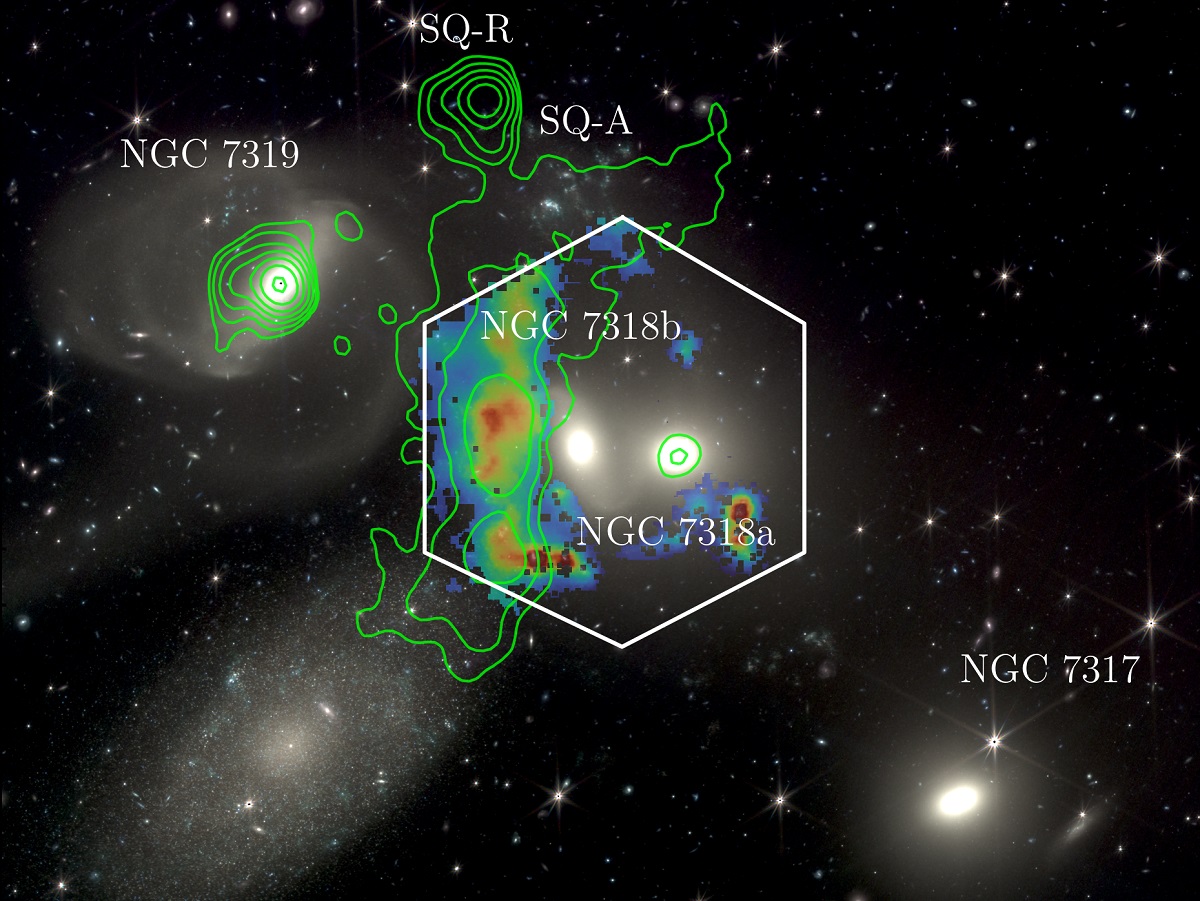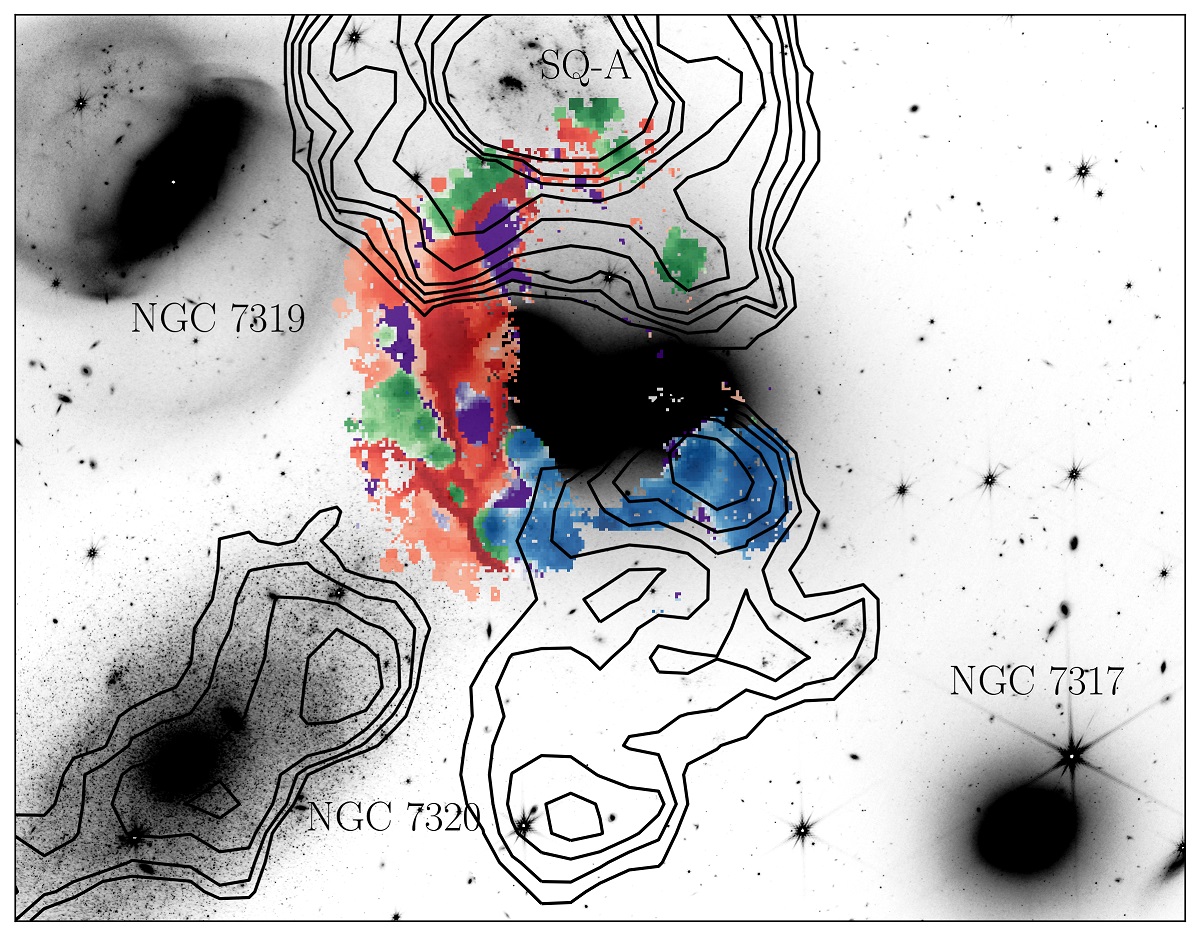First scientific results from WEAVE yield new insight into collisions in Stephan’s Quintet group of galaxies
- This galactic system is an ideal laboratory to understand the chaotic and often violent relationship between galaxies
- WEAVE shows up as a versatile instrument that, combined with Gaia, will allow to tackle a wide range of scientific cases, from stellar physics, to Galactic or extragalactic physics
- IEEC researchers at the Institute of Cosmos Sciences (ICCUB) have participated in the study, published in the journal Monthly Notices of the Royal Astronomical Society

Caption: WEAVE data overlaid on a James Webb Space Telescope image of Stephan’s Quintet, with green contours showing radio data from LOFAR (see main text). The orange and blue colours follow the brightness of Hydrogen-alpha obtained with the WEAVE LIFU (see main text), which trace where the intergalactic gas is ionised. The hexagon denotes the approximate coverage of the new WEAVE observations of the system, which is similar in size to our own galaxy, the Milky Way.
Credits: Arnaudova et al.
An international team of more than 50 astronomers, led by the University of Hertfordshire, has presented the first scientific results of the new WEAVE (acronym for William Herschel Telescope Enhanced Area Velocity Explorer) wide-field spectrograph. They have used the set of first-light observations on Stephan’s Quintet, a nearby galaxy group that represents a crossroad where past collisions between galaxies have left behind a complex field of debris. Researchers from the Institute of Space Studies of Catalonia (IEEC — Institut d’Estudis Espacials de Catalunya) at the Institute of Cosmos Sciences of the University of Barcelona (ICCUB) have participated in this study, published in the journal Monthly Notices of the Royal Astronomical Society.
Stephan’s Quintet is a galaxy group discovered in 1877 that consists of five galaxies (named NGC 7317, NGC 7318a, NGC 7318b, NGC 7319 and NGC 7320c). This system is an ideal laboratory to understand the chaotic and often violent relationship between galaxies, and as such was the focus of the first-light observations by the WEAVE Large Integral Field Unit (LIFU).
Marina Arnaudova, team leader at the University of Hertfordshire, says: “Dynamical activity in this galaxy group has now been reawakened by NGC 7318b, a galaxy smashing through it at an incredible speed of over 2 million miles per hour (3.2 million kilometres per hour), leading to an immensely powerful shock, much like a sonic boom from a jet fighter.” She and her team provide a new insight into the large-scale shock front.
By combining data from WEAVE’s LIFU with other cutting-edge instruments such as the Low Frequency Array (LOFAR), the Very Large Array (VLA), and the James Webb Space Telescope (JWST), they have found a previously undiscovered dual nature of the shock: as the shock moves through pockets of cold gas, it travels at hypersonic speeds—several times the speed of sound—powerful enough to rip apart electrons from atoms, leaving behind a glowing trail of charged gas, as seen with WEAVE; however, when the shock passes through the surrounding hot gas, it becomes much weaker. Instead of causing significant disruption, the weak shock compresses the hot gas, resulting in radio waves that are picked up by radio telescopes (like LOFAR).

Caption: WEAVE decomposition of gas in Stephan’s Quintet, overlaid on a JWST image. The red highlights gas shocked by the collision, while green and blue shows star-forming regions. The purple areas represent bubbles with an unknown origin. The black contours show neutral Hydrogen, and its location relative to the shocked gas (in red) suggests that is where it comes from.
Credits: Arnaudova et al.
The Catalan contribution to the WEAVE spectrograph
This project involves scientists from the ICCUB and the Universitat Politècnica de Catalunya – BarcelonaTech (UPC). The Catalan institutions have worked, from the beginning of the project, on the definition of the scientific objectives and the selection of the objects to be observed—from stars in various evolutionary phases to star clusters—as well as in the sampling of quasars, which are extremely bright and very distant active galactic nuclei. Specifically, Mercè Romero-Gómez (ICCUB-IEEC) and Roberto Raddi (UPC) are members of the international working groups on young stars, galactic archaeology and white dwarfs that make up the team of scientists responsible for planning the observations. Teresa Antoja (ICCUB-IEEC) and Ignasi Pérez-Ràfols (UPC) co-lead the research teams responsible for galactic disc dynamics and quasars, respectively.
Romero-Gómez says: “After years of preparation, we have been able to obtain the first spectra with the Large Integral Field Unit of WEAVE from Stephan’s Quintet group of galaxies. The quality of the spectra has allowed us to reassess the dynamical processes happening in this well-known set of galaxies.”
Raddi and Pérez-Ràfols, in turn, have commented that their teams will contribute to the study of some 100,000 white dwarfs previously identified by the Gaia mission of the European Space Agency (ESA), and discover the secrets behind the last evolutionary phases of Sun-like stars, and with the identification of 450,000 quasars, the most distant and bright active galactic nuclei in the universe.
In the following year, data coming from the Multi-Object Spectrograph will allow us to assess the dynamics of our own Galaxy, together with the astrometric and spectroscopic data from Gaia.
WEAVE, a new generation spectrograph
The WEAVE spectrograph uses optical fibres to collect light from celestial objects and transmits it to a spectrograph that separates the light according to its different wavelengths. It can work at two different spectral resolutions, which are used to measure the speeds of objects in the line of sight (using the Doppler effect) and to determine their chemical composition. The versatility of WEAVE is one of its main strengths. While the LIFU mode contains hundreds of fibres in a compact distribution, essential for imaging extended areas of the sky, in the MOS (multi-object spectroscopy) mode about a thousand individual fibres can be placed (by two robots) to simultaneously collect light from stars, galaxies or quasars. During the first five years of operation, spectra of millions of individual stars and galaxies are expected, a goal that can be achieved thanks to the WEAVE spectrograph’s ability to observe so many bodies at once.
More information
This research is presented in a paper entitled “WEAVE First Light observations: Origin and Dynamics of the Shock Front in Stephan’s Quintet”, by M. I. Arnaudova et al., to appear in the journal MNRAS on 22 November 2024.
Contacts
IEEC Communication Office
Castelldefels, Barcelona
E-mail: comunicacio@ieec.cat
Lead Researcher at the IEEC
Mercè Romero
Institute of Space Studies of Catalonia (IEEC)
Institute of Cosmos Sciences (ICCUB)
E-mail: mromero@ieec.cat, mromero@icc.ub.edu
About the IEEC
The Institute of Space Studies of Catalonia (IEEC — Institut d’Estudis Espacials de Catalunya) promotes and coordinates space research and technology development in Catalonia for the benefit of society. IEEC fosters collaborations both locally and worldwide and is an efficient agent of knowledge, innovation and technology transfer. As a result of more than 25 years of high-quality research, done in collaboration with major international organisations, IEEC ranks among the best international research centres, focusing on areas such as: astrophysics, cosmology, planetary science, and Earth Observation. IEEC’s engineering division develops instrumentation for ground- and space-based projects, and has extensive experience in working with private or public organisations from the aerospace and other innovation sectors.
The IEEC is a non-profit public sector foundation that was established in February 1996. It has a Board of Trustees composed of the Generalitat de Catalunya, Universitat de Barcelona (UB), Universitat Autònoma de Barcelona (UAB), Universitat Politècnica de Catalunya · BarcelonaTech (UPC), and the Spanish Research Council (CSIC). The IEEC is also a CERCA centre.
